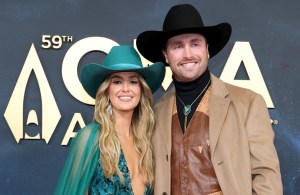Chip and Joanna Gaines’ Magnolia Network has been delivering must-watch TV since its launch. But their latest hit, Back to the Frontier, was unlike anything ever shown in unscripted television.
The series transports three modern-day American families to the 1880s as they experience life without modern luxuries. Families live a more “simple life,” but the transition doesn’t come easy; however, the familial connection gained throughout the filming process is the show’s ultimate test.
Videos by PopCulture.com
“Three American families leave the 21st century behind and attempt to survive as 1880s homesteaders – without running water or electricity,” the synopsis reads. “They tackle historical challenges and learn the skills that frontier families needed to survive a long winter.”
Inspired by the Homestead Act of 1862, the experience was designed to mock life during that time period. Per the act, enacted by President Abraham Lincoln, any U.S. citizen (or intended citizen) could claim 160 acres of public land in the West, with the stipulation of living on it, building and improving it, and paying a small registration fee. If done correctly, after five years, they owned the land. At the time, the act was built to encourage westward expansion and agricultural development by making landownership accessible to a wider population.
Last fall, PopCulture was invited to a set visit right outside of Calgary, Canada on the last day of filming where they spoke with each family about their experiences. All of them had one common theme on what lessons and experiences they’ll keep.
Meet the Families of Back to the Frontier
For eight weeks, the Lopers from Alabama, the Hanna-Riggs from Texas and the Halls from Florida lived as 1880s homesteaders in a remote wilderness in Alberta, Canada. It turned out to be more than they signed up for, but the unique experience bonded everyone involved.
For Jason Hanna and Joe Riggs, it was an opportunity for their 10-year-old twin sons, Ethan and Lucas, to learn survival skills. The couple live in a smart home, and admit they use technology as a reward and punishment for their boys. As the only same-sex couple in the experiment, they had to figure out a way to challenge the gender roles of the time period.
Jereme Hall and his wife Lina and their three kids, Mia, Zoe and Jet, were interested in the experiment to live in a different time. Always close-knit and on new adventures, this specific project tested even their closeness.
Joaquin and Stacey Loper‘s experience on the frontier was nostalgic to how Joaquin lived during his childhood on a farm in the South. Stacey was apprehensive, yet a team player, and Joaquin wanted his sons, Landen and Maddox, to share a similar experience as he did growing up.
The Biggest Challenges for Each Back to the Frontier Family
Each family got to work, arriving at each homestead to an unfinished house. The Lopers had to build walls and doors for safety. The Halls had to build beds for each child to sleep in, or share, depending on their choice. The biggest adjustment was adapting to gender roles, specifically for the Hanna-Riggs family.
In the 1800s, women handled the domestics, while the men worked. Jason and Joe had to determine who would be in which role, which was difficult considering they share equal responsibility at home in Texas.
“In the 21st century, we really divided pretty much everything equally. It’s the way it’s always been. I thing the only thing we ever split is I am the one on the grill and Jason makes the sides in the house,” Joe says. “In terms of being handy, which is required from a homesteader, that’s more of Joe’s thing. If I want to go buy something, Joe would put it together. But in terms of parenting, we always pull our weight independently and together. We both work from home, which allows us to be active as parents and in the community. So having to say, ‘One parent is responsible for the kids’ was a foreign concept.”
Because their children are more privileged in terms of not having typical chores and living in a smart house where things are done for them, the Hanna-Riggs family admits their sons were not happy campers at the beginning of the experiment.
“I think initially they had a lot of resentment towards us coming into this where they never really wanted to do this experiment, but we also thought it would be a great learning experience for them, teaching them responsibility, and learning how to operate without devices, and that’s been one of our things in the 21st century which is an incentive, but they’re also the consequence,” Jason explains.
Joe knew the boys could do it, but it would take reinforcement. “There were ebbs and flows because there were times where the boys would jump into whatever was required of them, and I think with the arrival of the animals kind of helped solidify their experience here,” Joe says. “ It gave them more of a purpose and more of a responsibility, and I think that’s what they really needed. And then once our juices kind of got flowing, then all of a sudden they want a widow, they want to make all of these little projects throughout the house like everywhere, so they want to participate.”
The Halls probably had the easiest transition out of the three families. They spend a lot of time in nature and doing DIY projects, both in business and for fun. “We’re handy, so we’re not afraid to take on a project and just figure it out,” Jereme gushes. “The shack was a little scary when we first walked in. But we quickly got excited and figured out how to make it our comfortable abode.”
For the Lopers, their purpose was more significant than the other families. During the 1800s, Black Homesteading wasn’t easy, but it provided an opportunity and a different sense of freedom post-slavery for true ownership and legacy building. It was something that Stacey took seriously.
Despite working in the home as the primary caregiver while her husband tended to the work outside, she had to be the backbone and foundation of the family. It was a different role for her, as Stacey, who owns her own therapy practice, happily admits she lives a soft life and doesn’t tend to domestics at home. She traded in five-star dining and luxury spa days for the experience for her family.
It was actually tough for the whole family to watch Stacey struggle to adjust, and Joaquin says she was the ultimate MVP by the end of the experience.
“I don’t even do laundry anymore. I have a service that I pay happily for convenience,” Stacey asserts. “My day to day looks like I would wake up and my husband would have my coffee at my bed. I check my, my messages, my emails, I don’t get the boys up for school in the morning. Joaquin does that.
She continued, “Joaquin is the morning person and I’m very career-driven. Joaquin cooks my breakfast. Joaquin cooks my dinner. He does all of the homemaking things and he loves it. I don’t like to do dishes. I don’t like to sweep. I don’t like to mop. The first day, I cried. And it’s funny because our kids watch my husband cater to me and take such great care of me that when they had to watch me sweep, mop, cook, wash tissues and clean since we’ve been here, they wanted to come in and they would ask production if they could help.”
The Best Part of the Back to the Frontier Experience for Each Family Member
In spite of challenges, each family says the time together was the most valuable. Without the distractions of the hustle and bustle of their lives in the respective cities married with social media and game systems, it forced them to get to know one another on a deeper level and be creative with fun.
For the Hanna-Riggs family, Joe and Jason were shocked by how outdoorsy their sons became. Not only did they love the animals they had to care for, and rely on for survival, they also built a fort. Oftentimes, the boys would have to be forced into the house. The Lopers boys enjoyed swimming in the river. The Hall family took pride in crafts.
Each child also bonded with one another. They attended school together, with the eldest Hall daughter serving as one of the teachers. It also provided them with an experience to interact with people from different backgrounds and age groups, teaching patience and understanding.
Living within a strict budget and learning to do things the hard way without the help of Siri or hired services also had its advantages. For milk, Stacey had to milk a cow, or risk her family going thirsty. In one episode, she literally is pulled around and has to chase the cow to get the job done. By the end of the experiment, she and the family cow, whom she affectionately named Big Shirley, were two peas in a pod.
Family time is what each family says they want to continue in the 21st century. For Stacey, she has a better appreciation for what her ancestors went through for her to live her life as she does today.
“We have two young men looking at us to what’s next, so how do we navigate this life after slavery,” Stacey says she had to consider daily while living as a homesteader. “I now understand the healing that needed to take place for those people who were coming out of that. I understand the traumas that have been handed down from one generation to the next generation to the next generation, and they have to heal from that. Because they did not know what else to do and then to come and establish land that could have very well been taken from you and you worked your butt off, but you had to have somebody else vouch for you to keep this land. That was hard for me to swallow. So I got so much more out of this experience than I expected to get out of this experience.”
Back to the Frontier is available to stream on HBO Max.








